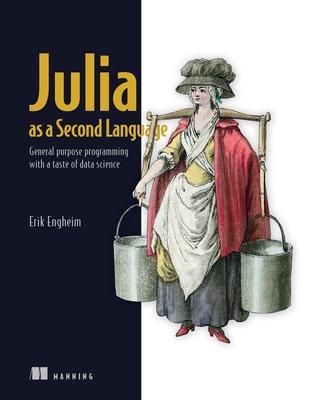- Data types like numbers, strings, arrays, and dictionaries
- Immediate feedback with Julia's read-evaluate-print-loop (REPL)
- Simplify code interactions with multiple dispatch
- Sharing code using modules and packages
- Object-oriented and functional programming styles
Julia as a Second Language introduces Julia to readers with a beginning-level knowledge of another language like Python or JavaScript. You'll learn by coding engaging hands-on projects that encourage you to apply what you're learning immediately. Don't be put off by Julia's reputation as a scientific programming language--there's no data science or numerical computing knowledge required. You can get started with what you learned in high school math classes. Purchase of the print book includes a free eBook in PDF, Kindle, and ePub formats from Manning Publications. About the Technology Originally designed for high-performance data science, Julia has become an awesome general purpose programming language. It offers developer-friendly features like garbage collection, dynamic typing, and a flexible approach to concurrency and distributed computing. It is the perfect mix of simplicity, flexibility and performance. About the Book Julia as a Second Language introduces Julia by building on your existing programming knowledge. You'll see Julia in action as you create a series of interesting projects that guide you from Julia's basic syntax through its advanced features. Master types and data structures as you model a rocket launch. Use dictionaries to interpret Roman numerals. Use Julia's unique multiple dispatch feature to send knights and archers into a simulated battle. Along the way, you'll even compare the object-oriented and functional programming styles-Julia supports both! What's Inside
- Data types like numbers, strings, arrays, and dictionaries
- Immediate feedback with Julia's read-evaluate-print-loop (REPL)
- Simplify code interactions with multiple dispatch
- Share code using modules and packages
About the Reader For readers comfortable with another programming language like Python, JavaScript, or C#. About the Author Erik Engheim is a writer, conference speaker, video course author, and software developer. Table of Contents PART 1 - BASICS
1 Why Julia?
2 Julia as a calculator
3 Control flow
4 Julia as a spreadsheet
5 Working with text
6 Storing data in dictionaries
PART 2 - TYPES
7 Understanding types
8 Building a rocket
9 Conversion and promotion
10 Representing unknown values
PART 3 - COLLECTIONS
11 Working with strings
12 Understanding Julia collections
13 Working with sets
14 Working with vectors and matrices
PART 4 - SOFTWARE ENGINEERING
15 Functional programming in Julia
16 Organizing and modularizing your code
PART 5 - GOING IN DEPTH
17 Input and output
18 Defining parametric types
